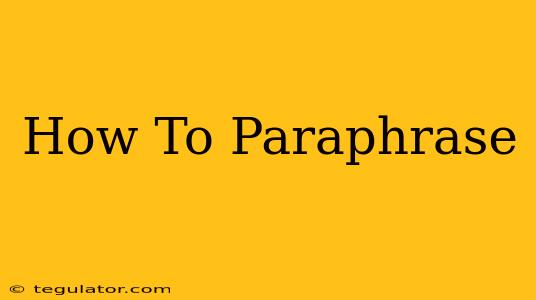Paraphrasing is a crucial skill for students, professionals, and anyone who works with text. It's more than just rearranging words; it's about understanding the original text and expressing its meaning in your own words while maintaining accuracy and clarity. This guide will equip you with the techniques and strategies to become a master paraphraser.
Understanding the Essence of Paraphrasing
Before diving into the "how-to," let's clarify what paraphrasing actually is. It's not about simply replacing a few words here and there or changing the sentence structure slightly. Effective paraphrasing involves:
- Comprehending the original text thoroughly: You must grasp the author's main idea, supporting arguments, and overall tone before attempting to reword it.
- Expressing the same meaning in different words: Your paraphrase should convey the same information as the original, but using your own vocabulary and sentence structure.
- Maintaining the original meaning and intent: Don't distort the author's message; your paraphrase should accurately reflect their point of view.
- Citing the original source: Always give credit to the original author to avoid plagiarism.
Step-by-Step Guide to Effective Paraphrasing
Here's a practical, step-by-step approach to paraphrasing effectively:
1. Read and Understand the Original Text
This seems obvious, but it's the most critical step. Read the text multiple times until you completely grasp its meaning. Identify the main idea and key supporting points. Consider the context and the author's purpose.
2. Identify Key Concepts and Ideas
Break down the original text into its core components. What are the main arguments or points the author is trying to make? Highlight these key concepts.
3. Use Synonyms and Different Sentence Structures
This is where the actual paraphrasing begins. Replace key words with synonyms while ensuring the meaning remains the same. Experiment with different sentence structures—change from active to passive voice or vice versa, combine short sentences into longer ones, or break down long sentences into shorter ones.
Example:
- Original: "The quick brown fox jumps over the lazy dog."
- Paraphrase: "A swift brown fox leaps over a canine that is sleeping."
Notice how the vocabulary and sentence structure have changed, but the core meaning remains identical.
4. Check for Accuracy and Clarity
After paraphrasing, carefully compare your version to the original. Does it convey the same information? Is it clear, concise, and easy to understand? Does it maintain the original author's intended meaning and tone? If not, revise your paraphrase until it meets these criteria.
5. Cite Your Source
Always properly cite the original source to avoid plagiarism. Use appropriate citation styles (MLA, APA, Chicago, etc.) depending on your requirements.
Common Mistakes to Avoid
- Simply changing a few words: This is not true paraphrasing and can be considered plagiarism.
- Misinterpreting the original text: Ensure you understand the original meaning before attempting to reword it.
- Failing to cite the source: Always give credit to the original author.
- Over-paraphrasing: While it's important to use your own words, don't make your paraphrase so different that it obscures the original meaning.
Mastering the Art of Paraphrasing
Paraphrasing is a skill that improves with practice. The more you practice, the better you'll become at understanding and rewording texts accurately and efficiently. By following these steps and avoiding common pitfalls, you'll enhance your paraphrasing abilities and improve your writing overall. Remember, effective paraphrasing is a sign of strong comprehension and effective communication.

